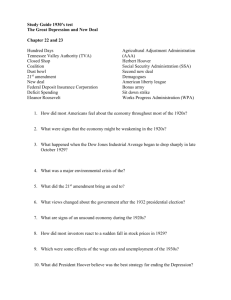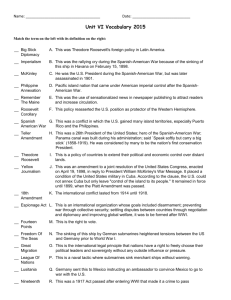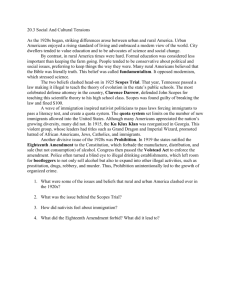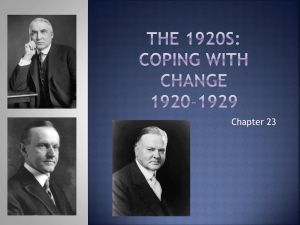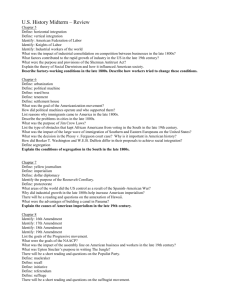11 th Grade TAKS Review
advertisement
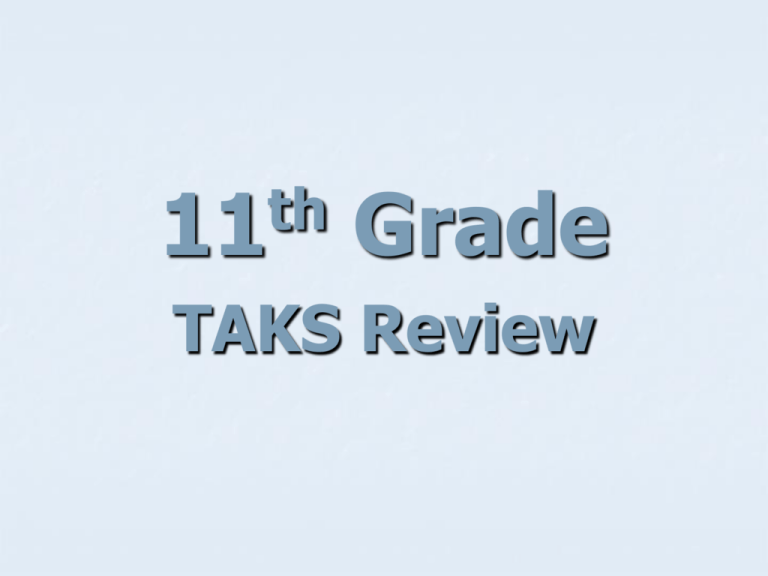
th 11 Grade TAKS Review th 19 Late Century (1877-1898) Industrialization Gilded Age Free Enterprise System All economic systems answer the following 3 questions: WHAT should be produced? HOW should it be produced? WHO should it go to? In the free enterprise system, people are free to produce what they can and to buy what they can afford. The interaction of decisions in the market by producers and consumers determines what is produced. Market-Oriented Agriculture Growing crops and raising animals for sale in the market to make a profit. Farm Issues Issues surrounding the production of agricultural products. The main issues were the high cost of transportation (caused railroad monopolies) low prices for farm products (caused by overproduction) mortgaged farms in order to buy seed and supplies. Industrialization Production of goods and products in factories by machines. Occurred in the late 19th century led to more goods being produced at lower prices new sources of energy replaced human and animal power factories and machines replaced the production of goods by hand (cottage industry) farmers left the countryside to work in cities, while population growth increased. Commercial Industry Products usually made in a factory by a machine to sell in a market. Production of manufactured goods in a market economic system. Big Business Large companies that control major portions of the economy Owners of big businesses became politically powerful because of their wealth from profits. Labor Union Workers who band together to demand better working conditions, shorter hours and higher pay COLLECTIVE BARGAINING allows all in the union to benefit equally . Child Labor Children under 14 years were exploited as workers. Children were often forced to do dangerous jobs or work long hours for low pay. Population Growth Increase of the number of people in an area (state, region, country) as result of increases in food/resources, migration, immigration. Migration Process of people moving to a new place to stay permanently or for a long time. Immigration Movement of people out of one country and into another. Note: people EMIgrate out of one country and IMMIgrate into another. Minority Group Any group of persons identified by race, ethnicity, religion, etc., and numbering less than 50 percent of total population. Urbanization Major move from countryside to cities in late 19th century Caused growth of cities and four major problems as a result: inadequate public services overcrowding social tensions corruption Economic Growth The growth of the economy of nation as measured by its gross domestic product (GDP) and at the personal level by per capita GDP. Standard of Living Level of development in a country, measured by factors like the amount of: personal income levels of education food consumption life expectancy availability of health care, ways natural resources are used level of technology Scientific Discoveries Technological improvements based on science such as the telephone, radio, airplanes, television, medicine, vaccinations, etc. Telegraph New form of communication over long distance, patented by Samuel Morse in 1837. Messages were sent using a code (Morse Code) in a matter of seconds. Railroads Helped westward expansion of the U.S. by carrying large amounts of goods, cattle, and people. Main means of transportation in U.S. from 1840s to 1940. Railroads also became politically powerful. Progressive Era and World War I 1898 Spanish-American War. Spanish-American War USS Maine attacked Feb. 15, 1898. U.S. defeated Spain in war, gained control of Cuba, Puerto Rico, the Philippines and Guam. Rough Riders, San Juan Hill – Theodore Roosevelt. Expansionism The belief in the early 2oth century that the United States needed to grow outside its continental boundaries. Areas of expansion included: American control of the Caribbean building of the Panama Canal acquisition of islands in the Pacific to be used as coaling stations for U.S. ships. Panama Canal Built between 1901 – 1914. Provides shortcut across narrowest portion of Central America to connect Atlantic and Pacific Ocean. Cost 5,000 lives to construct, 50 mile long canal Theodore Roosevelt 26th US president (1901-09) Hero of Spanish-American War Moved U.S. into position as a world power Reform president during progressive period, Conservationist Founder Bull Moose Party "Speak softly, but carry a big stick!" Square Deal Rough Riders World Power A nation becoming a dominant force throughout the world. This process usually involves colonization having a strong military presence the protection of countries weaker than it against other world powers. Reform The need to change things for the better. Some of the major areas of reform in US history were: abolition of slavery working conditions and pay moral issues Muckrakers Prohibition Second Great Awakening spoils system urban welfare women and children in the workplace civil rights business practices 16th Amendment Established a national income tax (1913). Congress has power to tax individual and corporate incomes. 17th Amendment Allowed voters to choose US senators (1913). Before 17th amendment US senators were chosen by state legislatures. Examples of popular sovereignty W.E.B. DuBois Early 2oth-century African-American political leader. Early member/founder of National Association for the Advancement of Colored People (NAACP). First Black to receive Ph.D. from Harvard University. Susan B. Anthony Leader of SUFFRAGETTE (women's voting rights) movement in 19th century. 1872: arrested in NY for trying to vote 19th Amendment approved 13 years after her death 19th Amendment Equal voting rights for women in federal and state elections (1920) Suffrage amendment Imperialism Domination of one country by another The quest for colonial empires. Examples for the United States: Hawaii, Spanish-American War, Philippines, Panama Canal, Latin America Militarism To glorify military strength. Before World War I, the arms race by major European powers developed large armies and more powerful weapons than their rivals. Strong nations began to form alliances to add even more strength to their military might. Nationalism National pride or loyalty - a cause of World War I which began in the Balkans with rival national groups, led to assassination of Archduke Ferdinand which started World War I. 1914-1918 World War I. Involved most of Europe, U.S. Allies v. Central Powers. U-boats sink Lusitania 128 US killed. U.S. enters war in 1917. War noteworthy because of cost, numbers of killed, and use of aircraft, tanks, poison gas and machine guns. World War I From 1914 to 1918 "The Great War" "War to End All Wars" Involved most of Europe. Allies vs. Central Powers. Unrestricted Submarine Warfare Germany's policy of sinking any ships on the seas to prevent war supplies from reaching its enemies, England and France. This practice forced the U.S. into World War I in 1917. Woodrow Wilson 28th President (1913-21) President during World War I. Wilson in his 14 Points offered conditions for ending World War I and called for creation of League of Nations to settle differences between countries. Progressive Democrat Wilson's Fourteen Points President Wilson's plan for the post-World War I world Included SELFDETERMINATION (self-rule) for small countries. League of Nations (preUN). Freedom of the seas. Treaty of Versailles Peace treaty ending World War I. Declared Allies winners of the war and set out terms of German REPARATIONS (payment for war damages) Based on Wilson's 14 Points. Between World Wars: 1920s and Great Depression Red Scare Fear in Western countries after World War I that Bolsheviks/Communists were trying to start revolutions and take over democracies. In the United States the Attorney General A. Mitchell Palmer conducted raids to deport aliens suspected of being Communists. After World War I. Prosperity "Good times" enjoyed by Americans in 1920s after World War I. Employment and wages were high and workers bought more consumer goods and had more leisure time. Henry Ford Inventor of "Model T" in 1905 and "Model A" cars. Introduced MASS PRODUCTION methods of building many cars quickly in a large factory. Assembly line in 1914. Scopes Trial Trial in Tennessee in 1925 involving John Scopes, biology teacher who taught theory of evolution at a time when only creation theory accepted in Tennessee and 12 other states "Monkey trial” Lawyers – Clarence Darrow vs. William Jennings Bryan Clarence Darrow Famous defense attorney known for flamboyant courtroom behavior and antics, defended Eugene Debs in 1894 union case Defended John Scopes in 1925 "Monkey Trial" William Jennings Bryan Nebraska congressman; candidate for president in 1896; Prosecuting attorney in John Scopes 1925 "Monkey Trial“ Bible man Presidential candidate in 1900 and 1908 elections Democrat POPULIST movement, which declared rich should pay more Prohibition US constitutional amendment (18th amendment) that made illegal the manufacture, transportation, possession, or sale of alcohol. Led to black market and rise of crime. Charles A. Lindbergh Hero of the 1920s. First aviator to cross the Atlantic non-stop in the "Spirit of St. Louis" aircraft (1927) New York to Paris in 33 hours Former US Army and airmail pilot 1929 Stock Market Crash Black Tuesday Oct. 29, 1929. End of prosperity period of 1920s with cheap credit, overvalued stocks, and consumer greed. Plunges U.S. and world into the Great Depression of the 1930s. Stock Market Crash October 1929: Thousands of investors go broke when stocks lose their value because of greed, margin buying and shady business deals. Beginning of the Great Depression. Bank Failures Bad bank loans drained cash out of peoples' savings accounts. Depositors later demanded their cash, which banks no longer held. Caused banks go bankrupt (fail). Depression A time of economic decline caused by a sharp drop in business activity accompanied by rising unemployment. The Great Depression (1929-1941) was a serious global economic decline that began with the crash of the U.S. stock market in 1929. Great Depression Began in 1929 and lasted throughout the 1930s. Economic crisis caused by stock market crash. Americans suffer job loss, hunger and other hardships for more than a decade. New Deal President Franklin Roosevelt's effort to jump-start the U.S. economy and create jobs. New Deal programs emphasized relief, recovery, and reform. FDIC Federal Deposit Insurance Corporation. Created to insure bank (checking and savings) accounts against loss in case of mismanagement or financial disasters. Social Security Act Passed in August 1935 as part of FDR's New Deal. Intended to protect American who were unable to support themselves - single parents, disabled, retired and elderly.
